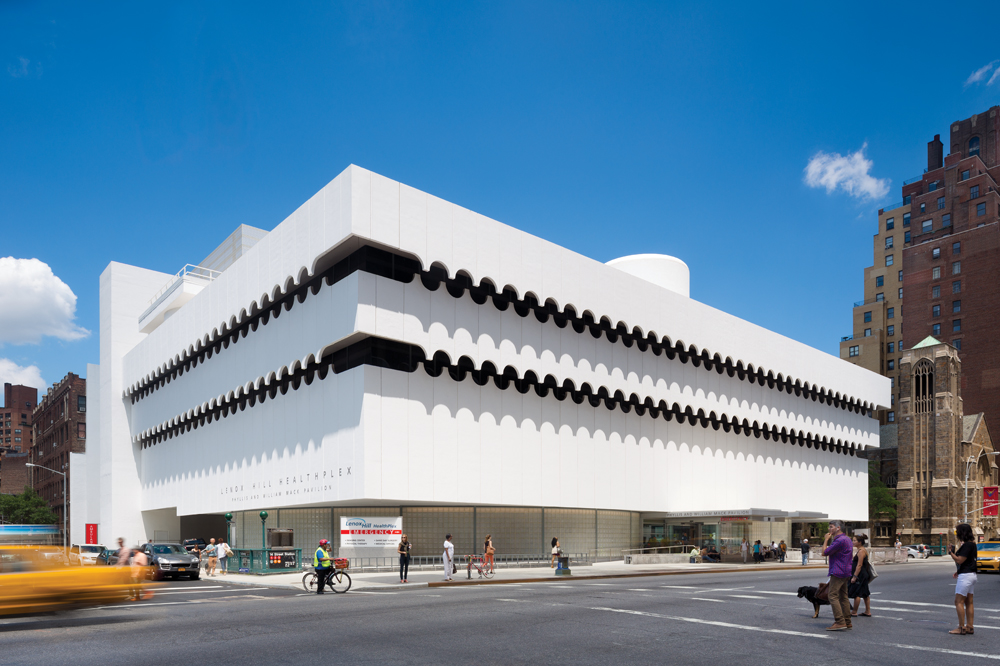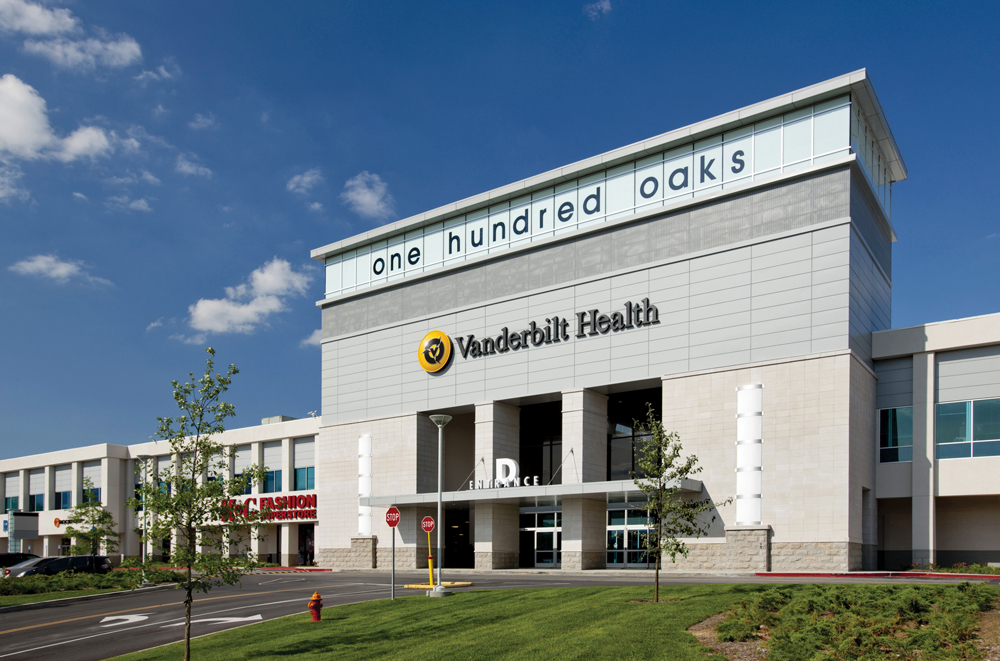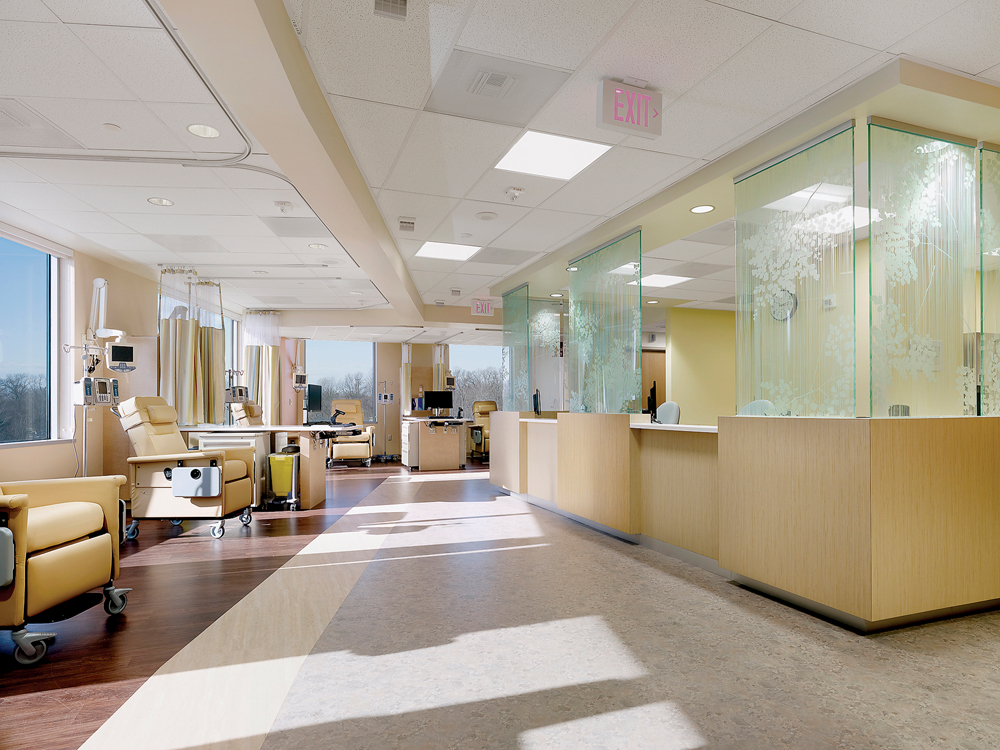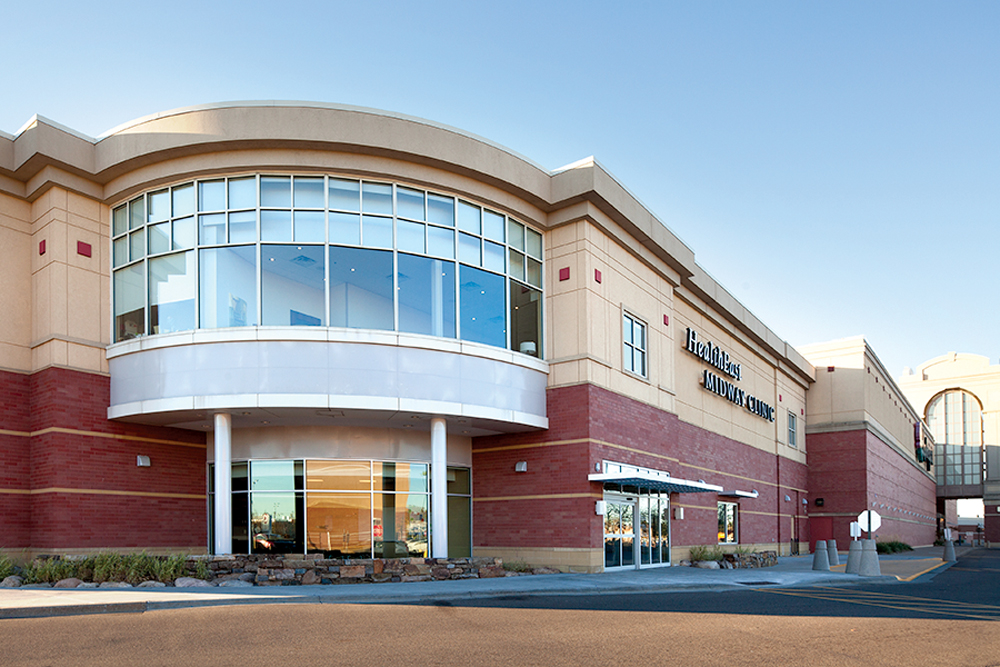When the physician group at Maryland Vascular Specialists was searching for a new location for its growing practice, a vacated Blockbuster store in Glen Burnie, roughly 11 miles south of Baltimore just outside the I-695 beltway, seemed like the perfect fit. At 5,000 sf, the building offered plenty of space for the practice. Its abundant windows flooded the interior with daylight, and the location was blessed with plenty of parking and easy pedestrian access. The lease rate was attractive, too.
It wasn’t until the group moved into its newly converted office that the physicians realized some of the drawbacks of selecting retail space over a traditional medical complex or corporate office building. For one thing, the building’s expansive glass and close proximity to the road—which seemed so enticing at the outset—left the occupants feeling a bit vulnerable.
“One of the things the doctors loved was all the windows around the building, especially the visibility they would get,” says Barbara Portnoy, CID, IIDA, LEED AP, Principal with PLDA Interiors, which performed the interiors and architecture work on the project. “However, when they moved in they realized everyone could see into their space. They felt vulnerable, given that someone driving right up to the front door at 10 o’clock at night was just steps away from their computers and medical equipment. That would not be a concern in a medical office building.”
That wasn’t the only problem. The building’s small vestibule left the reception and waiting areas exposed to the outside elements. And the foundation had to be reinforced, at considerable cost, to accommodate the installation of two hyperbaric chambers that were added to the program midway through the project.
25 questions to ask when evaluating existing structures for outpatient care
SITE
1. Does the site have ample parking?
2. Will the existing traffic flow pattern work for the healthcare client?
3. Is the site ADA-compliant?
4. Can it accommodate patient drop-off and pickup? What about delivery of medical supplies, food, linen, cleaning supplies, etc.?
5. Are there potential security risks due to the location, building orientation, or site configuration?
6. Are there opportunities for signage and other branding components?
7. Will neighboring tenants pose potential noise or traffic issues?
8. Are there any special regulatory requirements or local development ordinances that apply to the property?CORE AND SHELL
9. Is the building ADA-compliant?
10. What changes are required to meet the code for outpatient care?
11. Is the building sprinklered?
12. Does it have ample ceiling heights?
13. Are the dimensions of the structural grid consistent throughout the building?
14. Can the elevators accommodate bulky or heavy medical equipment?
15. Are the elevators and fire stairs in the proper locations?
16. Does the structure meet vibration and strength standards for healthcare?
17. Are the floors completely level?
18. What is the condition of the building envelope?
19. Does the building provide sufficient daylight? If not, can windows and skylights be added easily?
20. Can the roof structure accommodate additional mechanical and emergency power systems?
21. Is the loading dock adequate for frequent deliveries?
22. Can the building and site accommodate future expansion?BUILDING SYSTEMS
23. Does the domestic water pressure meet the needs of the outpatient tenant?
24. Will the existing plumbing infrastructure accommodate heavy water use?
25. Can any portion of the MEP/FP systems be reused?Sources: Compiled by BD+C with help from AECOM, Gresham, Smith and Partners, Perkins Eastman, PLDA Interiors, and Turner Construction
“The conversion was much more complicated than we had anticipated,” says Portnoy, who has led several healthcare adaptive-reuse projects over the past five years, mostly in retail environments. Recycling retail buildings for healthcare functions can have its advantages—speed to market, prime location, access to new patient populations—but such projects often pose “unique challenges,” she says.
While adaptive-reuse projects represent just a tiny niche within the $19 billion healthcare construction market, they are becoming more common, due to the shifting model of healthcare delivery toward lower-cost wellness-based care, still-depressed commercial lease rates in many markets, ready availability of retail and office space, and the growing desire of healthcare organizations to offer neighborhood-based services.
The savings versus new construction can be significant, exceeding 30% of the overall cost of construction, depending on the healthcare function and condition of the existing structure, says Steven P. Johnson, AIA, NCARB, Corporate Principal with Gresham, Smith and Partners (GS&P).
“Despite the difficultly of conversion projects, they’re worth the effort in many cases,” says Johnson. “There’s infrastructure already in place that has significant residual value, including a site, parking lot, frame of a building, and envelope. You can save 20-30% of the cost just in those items.”
Johnson led the design team for one of the most effective healthcare conversion projects to date: the Vanderbilt Medical Center at One Hundred Oaks Mall in Nashville, Tenn., a 880,000-sf, mixed-use medical office center for Vanderbilt University housed in a vacant 1960s indoor shopping mall.
“Our final calculations showed overall cost savings in the 20-25% range for the project, and that doesn’t count the cost of a new parking garage that would have been required if Vanderbilt had gone with new construction for this project,” he says.
BD+C asked leading healthcare planning and design experts for their advice on how to avoid the worst problems associated with healthcare adaptive-reuse projects. Here’s what they said:
1. Put your security antennae on high alert.
As the doctors at Maryland Vascular Specialists learned, being too close to the action can have its disadvantages. Traditional commercial office and medical real estate developments are designed with features—buffers, setbacks, large vestibules, lobbies, hardy landscaping—to enhance security. Most retail space (with the exception of indoor shopping malls), while cheaper than traditional MOB space, is relatively vulnerable. It’s a tradeoff that Building Teams must help their healthcare clients evaluate.
Another huge risk of reusing retail space: having little or no control over noisy or obnoxious neighbors. Portnoy recalls one healthcare client who moved into a single-story multipurpose building adjacent to a daycare center. “The client didn’t think the noise level was going to be an issue,” she says. “It was incredibly noisy and disruptive at certain times of the day.”
2. Don’t count on reusing the mechanical system.
GS&P’s Johnson says he’s seen too many Building Teams waste precious time and resources trying to salvage the existing mechanical systems on healthcare conversion projects. Outside of light medical applications, HVAC systems in existing retail and commercial office buildings—even newer developments—will not meet the code and performance requirements for healthcare applications.
“Retail HVAC systems are designed for big, open spaces. They’re not zoned very well,” says Johnson. “For the most part, they are basic on-and-off setups and can’t be scaled up to the controllability that is needed for healthcare.” Poor filtration and humidity control can also be a nuisance.
Johnson’s advice: Build the cost of a total rip-out and replacement into the initial feasibility budget.
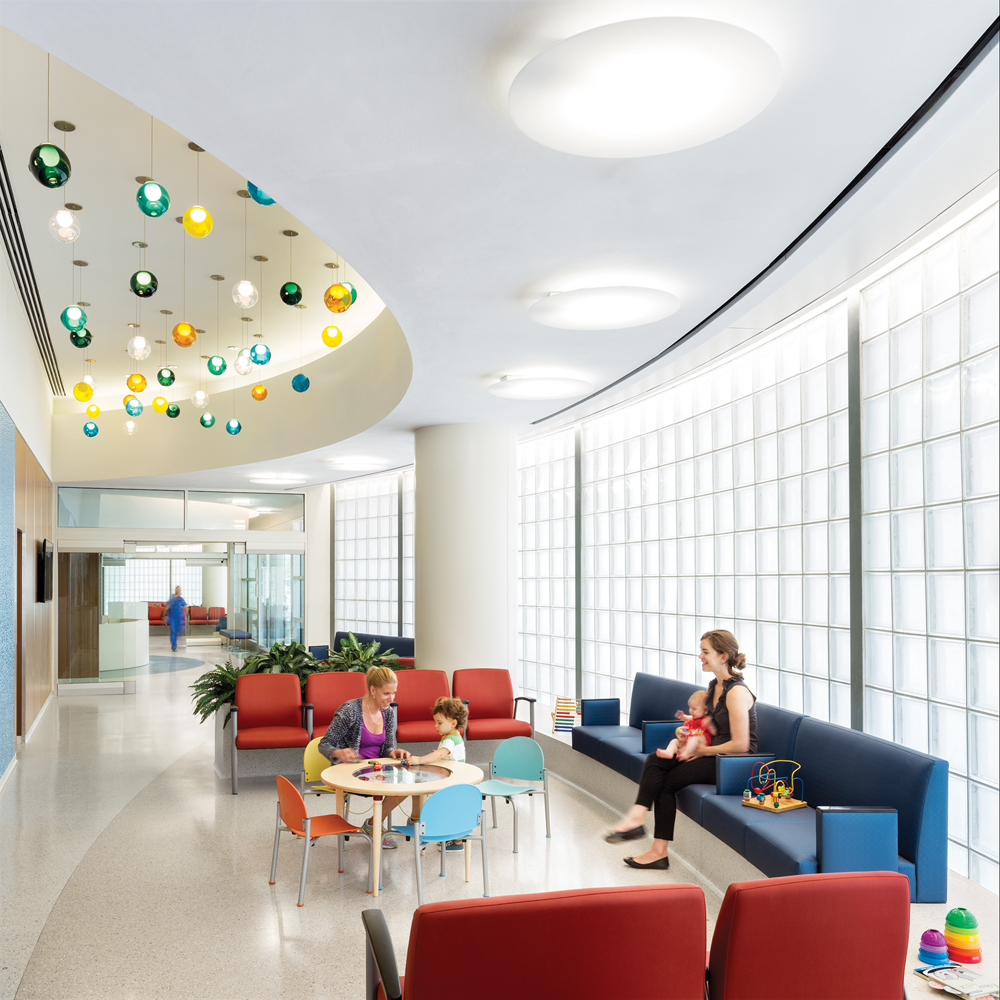
Lenox Hill Hospital HealthPlex, Manhattan. Photo: Chris Cooper
3. Watch those floor-to-floor heights.
The 10- or 11-foot ceiling heights common to commercial office buildings and strip retail centers rarely work for healthcare facilities, especially those that incorporate surgical spaces. Look for properties with a minimum ceiling height of 13 feet, advises Chip Cogswell, National Healthcare Director at Turner Construction. “In a new outpatient surgery suite, the ceiling height is usually 13 to 14 feet because of the size of the ductwork needed in the operating rooms,” he says. Surgical spaces in new hospitals, he notes, have a ceiling height of 15 feet.
But don’t rule out a location just because of low ceiling heights. You may be able to work around the restriction by building an addition to house the systems-intensive functions, or locating the mechanical systems on the roof.
Kaiser Permanente’s Gaithersburg (Md.) Medical Center, which is housed in a six-story, 200,000-sf former office building, had 11-foot ceilings. The design team, led by AECOM, located the surgical suites and other critical functions on the top floor in order to minimize supply and return ductwork and eliminate the need for duct shafts within the spaces. A dedicated rooftop air-conditioning unit was installed on the roof to serve this area.
“The key was identifying spaces within the building requiring return ductwork early during the programming phase of the project,” says Dave Tash, PE, LEED AP BD+C, Engineering Manager, Director, and Principal in AECOM’s Washington, D.C., office. “This knowledge helped our design team to better coordinate and locate such spaces within the building in order to minimize duct and utility crossings within the limited ceiling spaces.”
4. Polish up your negotiating skills, especially for fire/life-safety requirements.
Just bringing the existing structure up to code for use as a healthcare facility can consume a sizable chunk of the budget—and even make the project financially impractical.
The Building Team for the Vanderbilt Medical Center knew this going into the project. The 40-year-old mall was plagued with narrow exit pathways, poorly located fire stairways, and antiquated hardware and fire protection systems. The GS&P-led team made it their mission to negotiate with local officials to meet the intent of the building code without having to completely retrofit the building.
Relocating the fire stairs would have been especially cost-prohibitive and time-consuming, so the team negotiated to keep them in place by increasing the width of the exit pathways and installing a new fire alarm system. “By working closely with the code officials, we were able to leave intact the vast majority of the egress system with some minor improvements,” says Johnson. “Agreeing to install the new fire alarm system bought us a lot of grace in terms of solving some of these problems.”
Johnson’s keys to successful negotiation: over-communicate and be extremely accommodating. Invite the code officials to the job site, rather than going to their office. Work around their schedules to make it easy for them to visit the site. Walk the site with them and let them appreciate your problems first-hand. “We were able to save a lot of money by doing that, and still made a safe building,” he says.
5. Anticipate the “unknown unknowns.”
There are always some things that simply cannot be planned for in adaptive-reuse projects. The potential for complications is magnified in healthcare work, given the stringent code and performance requirements. Even with the most careful due diligence, be prepared for complications, says GS&P’s Johnson. On the Vanderbilt Medical Center project, it wasn’t until months into the work that the team realized the floor slabs were not completely level. Other portions of the floor were missing steel reinforcement altogether.
“They were level enough for a shoe store, but not for healthcare, with the sensitive equipment involved,” says Johnson. The complication required the team to rally and develop a solution in days in order to keep the project on schedule.
The trick is to operate as nimbly as possible as a team, says Jeffrey Brand, AIA, Principal, Executive Director, and National Healthcare Leader at Perkins Eastman. “Just understand that there are things that you will be required to do that are not in the original plan,” says Brand, who led the design team on the recently completed conversion of Manhattan’s landmark Curran O’Toole Building into the borough’s first freestanding emergency center, the Lenox Hill Hospital HealthPlex.
On that project, the New York State Department of Health mandated that the outpatient facility program include at least two inpatient rooms, with windows—not an easy task when dealing with a landmark façade—and full bathrooms. “We had to meet regulatory elements that were not exactly written in the guidelines, but were mandated in conversations” with code officials, says Brand.
Learning from four high-profile healthcare adaptive-reuse projects
1. Vanderbilt Medical Center at One Hundred Oaks Mall, Nashville, Tenn.
Former 1960s-era indoor shopping mall adapted into 880,000-sf, mixed-use medical office center for Vanderbilt University
Completed: January 2009
Building Team: ATR & Associates, Corinth Properties (developers); Gresham, Smith and Partners (architect, interior designer, transportation engineer); Envision Advantage (MEP); EMC Structural Engineers (SE); Batten & Shaw (contractor)
Problems
Structure was woefully out of code
Floors were not level and missing steel reinforcement in select areas
Windowless shell created dark interior spaces
Plumbing infrastructure was outdated and undersized for healthcare use
Solutions
Complete gut and rebuild of interior spaces and MEP/FP systems
Added second- and third-story windows to introduce daylight to interior spaces
Reconfigured vehicle traffic flow on the site
Lessons
Negotiate with code officials to meet intent of code with minimal changes
Over-communicate with Building Team members and code and city officials to resolve issues as quickly as possible
Perform thorough inspections of structure and infrastructure at the outset
2. Kaiser Permanente Gaithersburg Medical Center, Gaithersburg, Md.
Six-story, 200,000-sf corporate office building converted to a robust outpatient clinic with 24-hour urgent care center, ambulatory surgery space, cancer infusion center, 24-hour pharmacy, and radiology center
Completed: March 2012
Building Team: Kaiser Permanente (owner); AECOM (architect); Jacobs (program manager); HITT Contracting (contractor)
Problems
Low ceiling heights could not easily accommodate ambulatory surgery suite
Domestic water pressure, hot-water heating, and electrical power were insufficient for ambulatory care
Existing engineering systems were not completely commissioned
Solutions
Installed new elevator to accommodate stretchers on all floors
Expanded loading dock
Added canopies at patient access points
Redesigned interior to mesh with Kaiser Permanente’s brand
Installed emergency power system and upgraded life-safety and mechanical systems
Lessons
Where low ceiling heights are a problem, locate space-intensive functions, such as surgical suites, on the top floor and use the roof to house mechanical systems serving those spaces.
In newer office buildings, salvage existing mechanical systems and modernize (in this case, with improved air infiltration and ventilation). A second, more-robust air-conditioning unit was needed for the surgery suites on this project.
3. Lenox Hill Hospital Healthplex, New York City
The once-endangered Curran O’Toole Building in Greenwich Village—designed in the early 1960s by Frank Lloyd Wright protégé Albert C. Ledner—was converted into Manhattan’s first freestanding emergency center, with a 24-hour ER, health and wellness spaces, imaging center, ambulatory suite, and outpatient rehabilitation facility.
Completed: July 2014
Building Team: North Shore-LIJ (owner); Jones Lang LaSalle (owner’s representative); Perkins Eastman (architect); Robert Silman Associates (SE, façade consultant); Bard, Rao + Athanas Consulting Engineers (MEP); Turner Construction (contractor)
Problems
Tight, urban site offered limited opportunities for egress for patients, staff, emergency vehicles, and deliveries
Landmark façade had to be preserved
Department of Health mandated inclusion of two inpatient rooms, requiring windows and full bathrooms in those areas
Solutions
Carved out a portion of the ground floor to accommodate an ambulance bay without disturbing the landmark façade
Demolished the interior to the core and completely rebuilt it, adding modern systems and infrastructure
Reinforced the existing structure to meet vibration standards on the surgical floor and roof; cut new shafts for ventilation
Lessons
Operate nimbly as a team to quickly solve unforeseen problems
Evaluate the need for enhanced security measures (lighting, cameras, staff, etc.) at the entrances
4. HealthEast Midway Internal Medicine Clinic, St. Paul, Minn.
Housed in a former Borders Bookstore in St. Paul’s Midway area, this 23,000-sf clinic has 18 exam rooms, eight intake rooms, four consult/checkout rooms, a laboratory, offices, and rooms for audiology, mammography, and X-ray.
Completion: April 2012
Building Team: MSP Commercial (owner/developer); HGA (architect); Welsh Construction (contractor)
Problems
Busy retail location was less than ideal for patient drop-offs and pickups
Big-box structure lacked windows and skylights
Expansive floor-to-floor heights complicated acoustic design
Solutions
Main entrance enlarged and moved to north side of building
Drop-off/pickup lane added
Windows and skylights installed to bring natural light to both floors
Lessons
With expansive ceiling heights and open plans come acoustical concerns, especially in outpatient facilities with multiple functions. To handle sound separation between rooms, the Building Team modified the interior wall construction with resilient channels—a type of framing with softer connections between the sheetrock and metal to help minimize sound reverberation. Also installed sound booths on the return air grills and specified a sound-masking system.
Related Stories
Healthcare Facilities | Mar 18, 2024
A modular construction solution to the mental healthcare crisis
Maria Ionescu, Senior Medical Planner, Stantec, shares a tested solution for the overburdened emergency department: Modular hub-and-spoke design.
Codes and Standards | Mar 18, 2024
New urban stormwater policies treat rainwater as a resource
U.S. cities are revamping how they handle stormwater to reduce flooding and capture rainfall and recharge aquifers. New policies reflect a change in mindset from treating stormwater as a nuisance to be quickly diverted away to capturing it as a resource.
Plumbing | Mar 18, 2024
EPA to revise criteria for WaterSense faucets and faucet accessories
The U.S. Environmental Protection Agency (EPA) plans to revise its criteria for faucets and faucet accessories to earn the WaterSense label. The specification launched in 2007; since then, most faucets now sold in the U.S. meet or exceed the current WaterSense maximum flow rate of 1.5 gallons per minute (gpm).
MFPRO+ New Projects | Mar 18, 2024
Luxury apartments in New York restore and renovate a century-old residential building
COOKFOX Architects has completed a luxury apartment building at 378 West End Avenue in New York City. The project restored and renovated the original residence built in 1915, while extending a new structure east on West 78th Street.
Multifamily Housing | Mar 18, 2024
YWCA building in Boston’s Back Bay converted into 210 affordable rental apartments
Renovation of YWCA at 140 Clarendon Street will serve 111 previously unhoused families and individuals.
Healthcare Facilities | Mar 17, 2024
5 criteria to optimize medical office design
Healthcare designers need to consider privacy, separate areas for practitioners, natural light, outdoor spaces, and thoughtful selection of materials for medical office buildings.
Construction Costs | Mar 15, 2024
Retail center construction costs for 2024
Data from Gordian shows the most recent costs per square foot for restaurants, social clubs, one-story department stores, retail stores and movie theaters in select cities.
Architects | Mar 15, 2024
4 ways to streamline your architectural practice
Vessel Architecture's Lindsay Straatmann highlights four habits that have helped her discover the key to mastering efficiency as an architect.
Healthcare Facilities | Mar 15, 2024
First comprehensive cancer hospital in Dubai to host specialized multidisciplinary care
Stantec was selected to lead the design team for the Hamdan Bin Rashid Cancer Hospital, Dubai’s first integrated, comprehensive cancer hospital. Named in honor of the late Sheikh Hamdan Bin Rashid Al Maktoum, the hospital is scheduled to open to patients in 2026.
Codes and Standards | Mar 15, 2024
Technical brief addresses the impact of construction-generated moisture on commercial roofing systems
A new technical brief from SPRI, the trade association representing the manufacturers of single-ply roofing systems and related component materials, addresses construction-generated moisture and its impact on commercial roofing systems.


